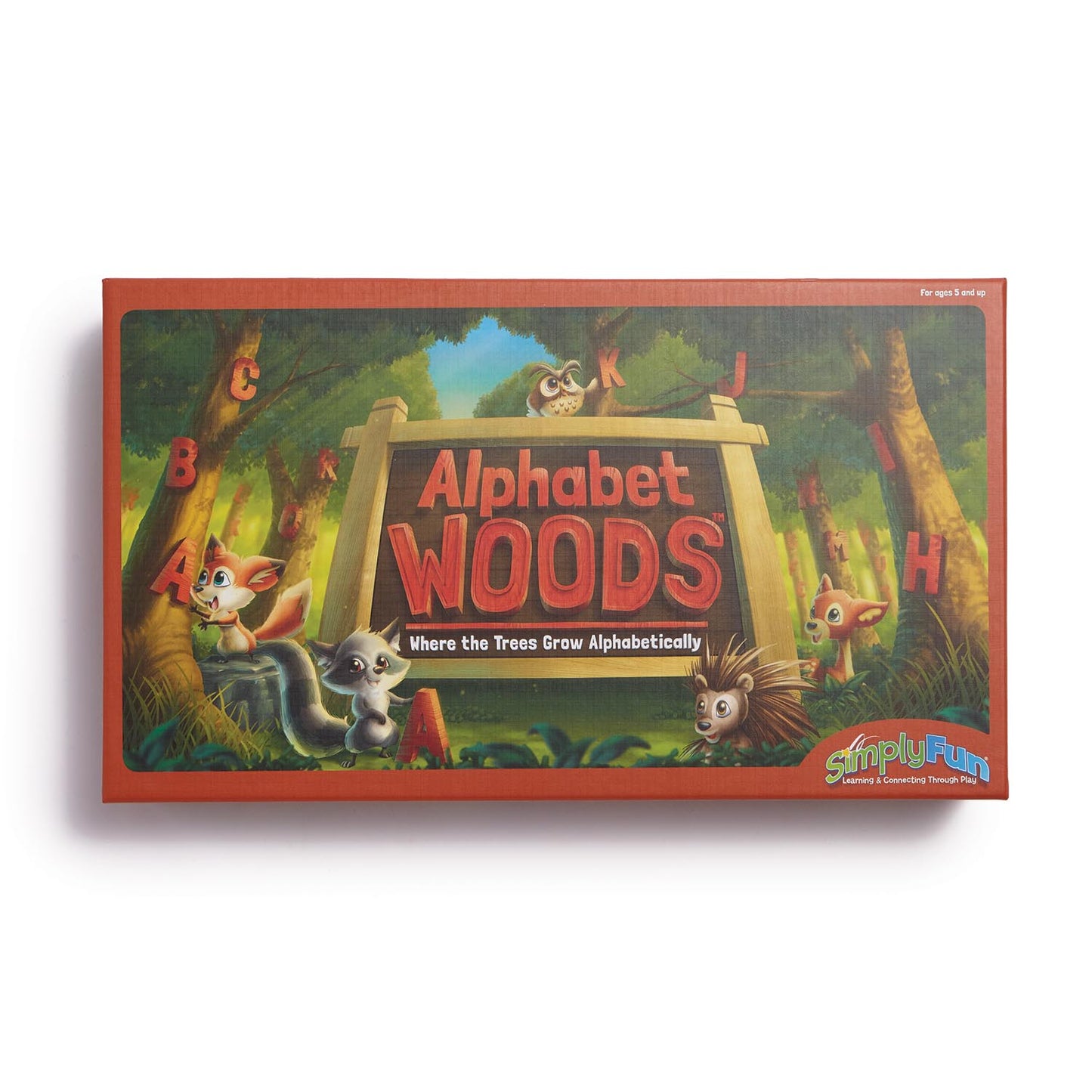
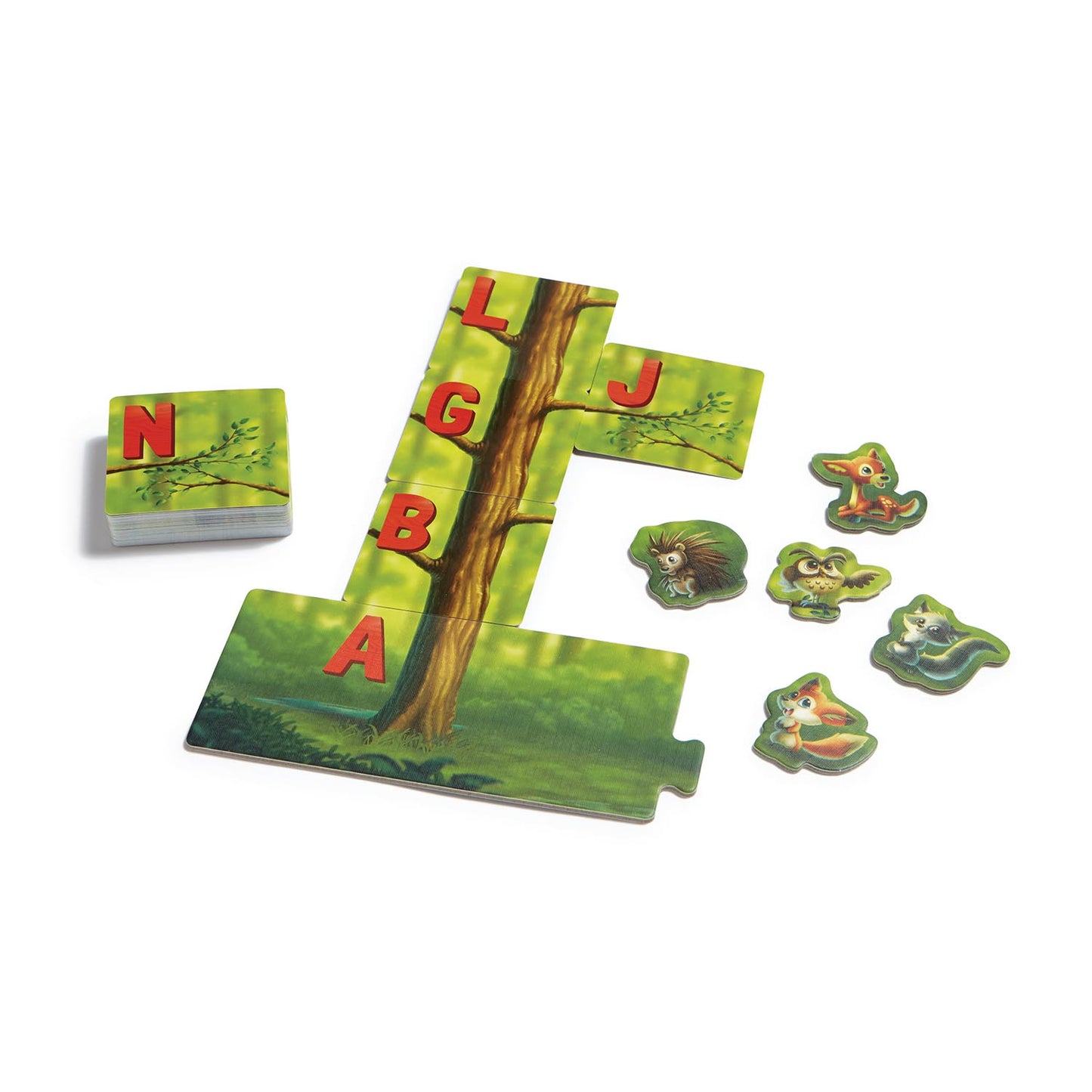
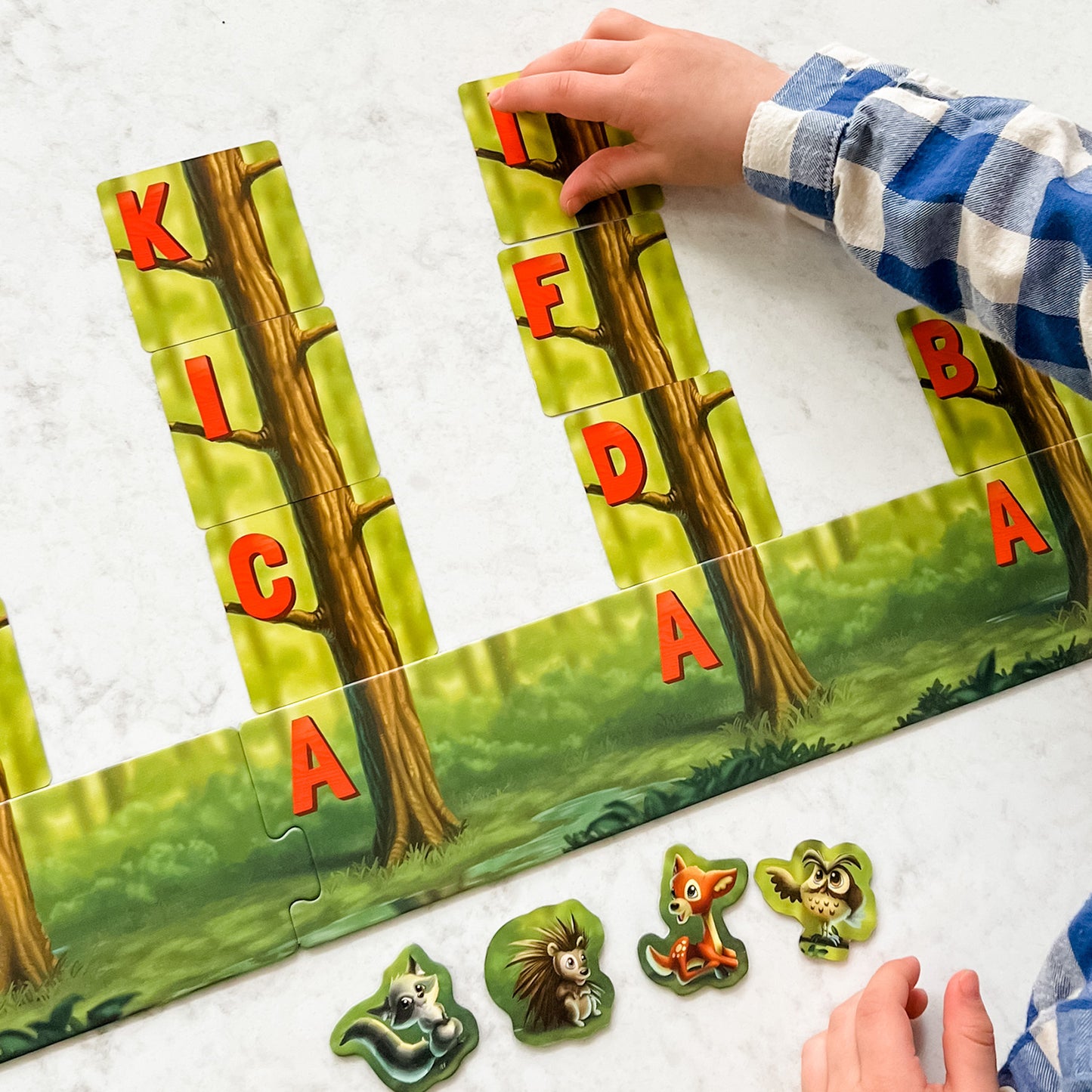
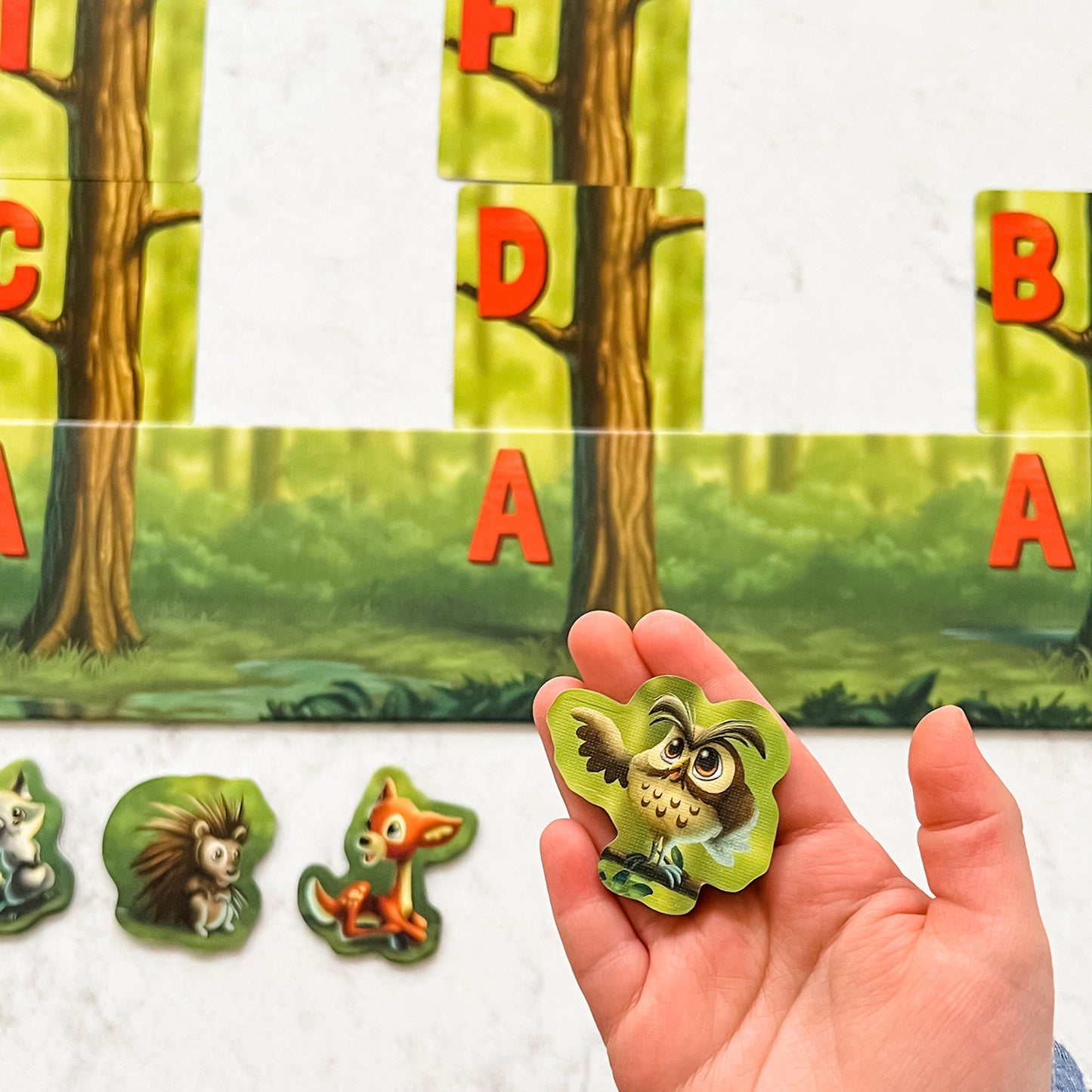
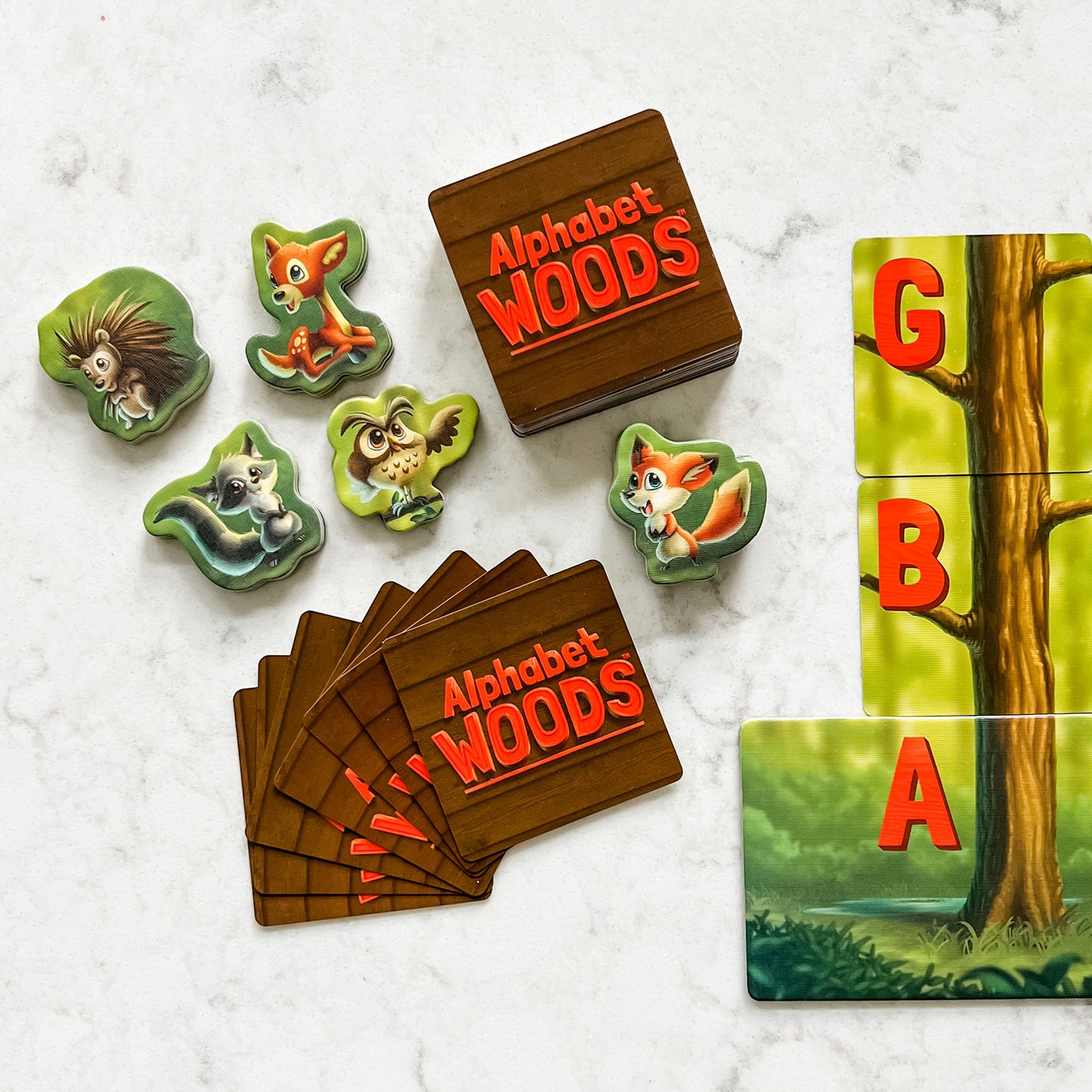


Collapsible content
Today we’re going to grow trees, collect forest animals and practice alphabetizing letters as we learn to play Simply Fun’s Alphabet Woods.
Alphabet Woods is a great game for people ages 5 and up, and can be played with 2 to 5 players.
In Alphabet Woods, players practice two skills
Alphabetizing… as they use the cards to build trees in alphabetical order, and
Sequencing, as they rely on their ability to put letters in alphabetical order.
To set up the game, assemble the 3 piece forest floor board like a puzzle and place it on one side of the table. There are five letter As and five tree trunks. This is the tree growing area!
Shuffle all the cards together. There are 3 kinds of cards in the deck - LETTER cards that you use to grow trees, BRANCH cards that you can use to connect trees and TREETOP cards to put on top of trees once they grow tall enough.
Deal seven cards to each player and place the remaining cards in a draw pile near the tree growing area, leaving a space for a discard pile.
Then, place the forest animals on the table where everyone can reach. For two or three player games, place 26 animals on the table and keep the rest in the box. For four to five player games, use all 52 of the animals.
Now we’re ready to play! The youngest player with a letter closest to an A goes first.
The object of the game is to collect the most forest animals by adding cards to trees in alphabetical order. Earn one animal for every card you place on a tree. The player with the most animals at the end of the game wins.
On your turn, first try to play a letter card in one of three ways:
• If you can, place one letter card at the top of any tree. The letter card doesn’t have to be the very next letter in the alphabet – like B after A – it just has to be a different letter and be in alphabetical order.
• Or place a letter card over any existing letter card (except the letter A) on the tree. The new letter must still keep the tree in alphabetical order.
• Or, you might have more than one card that is in a row in the alphabet, like B and C. This is called a run. If you have a run, you can place two or more letter cards at the top of any tree as long as the whole tree remains in alphabetical order.
Now look to see if it is possible to play a branch or treetop card.
• At any time on a turn, a player may add one branch card between two trees – or over an existing branch card – as long as both trees stay in alphabetical order. Branch letters may be the same letter OR a different letter than the lower two cards they connect on the tree.
• At any time on a turn, if a tree is 7 letters tall, including the A, and a player has a treetop card in hand, they may place it at the top of the tree. This tree is now fully grown and may not get taller. BUT, players may still lay letter cards over existing cards on the tree, or add branches. All as long as everything stays in alphabetical order!
After playing one or more cards in a turn, players then collect a forest animal for every card played, and replenish their hands to seven cards. Then, a player’s turn is over, and play continues with the next player, in clockwise order.
Once all the forest animals are collected, the game is over, and the player who has the most animals wins the game!
For an easier version of the game, play without the branch cards. For variations on the game, especially for players just learning to alphabetize, refer to the instruction booklet in the box.
Grow your alphabetizing skills AND a forest full of trees and critters with Simply Fun’s Alphabet Woods!


Core Standard*: Language
- Reading
- Print Concepts: Grade Level K
- Foundational Skills


Explore
What Does Child Do To Use Skill In The Game?
Players need to look around the Tree Growing Area throughout the game to locate places where to play Letter and Branch Cards
How Parents Can Assist Learning
Remind children to look at all the potential cards they can play on their turn, including placing Branch and Treetop cards. This will encourage patience and discourage impulsivity.
Learning Implications and Educator Support
Remind children to look at all the potential cards they can play on their turn, including placing Branch and Treetop cards. This will encourage patience and discourage impulsivity.
Determine
What Does Child Do To Use Skill In The Game?
Players examine the different letters and letter sequences to determine which, if any, of their Letter and Branch Cards can be played. Additionally, if a player has a Treetop Card, they decide when is the best time to play it once a tree is at least 7 letters tall
How Parents Can Assist Learning
Parents can make suggestions for how to analyze the sequences, especially for Branch Cards. For example, if one tree has the letters M & Q and the next one over has N & R at the same level, you might say, "I see a branching opportunity for a tree with the letter M. Can you see it?" When the child discovers the area, ask which Letter Cards could be used. In this example, letters O and P work.
Learning Implications and Educator Support
Alphabet Woods is a great game for teaching alphabetizing, the alphabet and general principles of sequencing. It also helps develop spatial reasoning and directionality as children look for opportunities to create or connect sequences vertically and horizontally. Educators can make suggestions for how to analyze the sequences, especially for Branch Cards. For example, if one tree has the letters M & Q and the next one over has N & R at the same level, you might say, "I see a branching opportunity for a tree with the letter M. Can you see it?" When the child discovers the area, ask the child which Letter Cards could be used. In this example, letters O and P work.
Compare
What Does Child Do To Use Skill In The Game?
Players compare their Letter and Branch Cards to options for playing cards on the Tree Growing Area.
How Parents Can Assist Learning
Making mental models of sequences is an advanced, complex cognitive skill that supports learning spatial relations, pattern recognition and creative problem solving. To help children learn these skills, ask them to describe aloud the different sequences and branching choices they can make, and to explain the benefits of the different options.
Learning Implications and Educator Support
Making mental models of sequences is an advanced, complex cognitive skill that supports learning spatial relations, pattern recognition and creative problem solving. To help children learn these skills, ask them to describe aloud the different sequences and branching choices they can make, and to explain the benefits of the different options.
Remember
What Does Child Do To Use Skill In The Game?
Players need to remember the alphabet sequence (A, B, C and so on) in order to determine if they have a Letter or Branch Card that can be played successfully.
How Parents Can Assist Learning
There is no special adult support required. However, if children are just learning their alphabet, it may be helpful to write out the letters on a piece of paper that they can refer to.
Learning Implications and Educator Support
There is no special adult support required. However, if children are just learning their alphabet, it may be helpful to write out the letters on a piece of paper that they can refer to.
*Data compiled from CCSSI ELA Standards, WA Science Standards, and Washington Social Studies Standards


Cognitive
Suggestions for How to Modify Play Experience
Play with fewer trees bases and no branches. For example, only use 2 or 3 tree bases. This reduces the number of options the child needs to consider.
Play in rounds. Divide the cards into Letter and Brand cards. Play the Letters first and then the Branches.
Communication
Suggestions for How to Modify Play Experience
The directions to Alphabet Woods are complicated because there are several possible moves on each turn, so children who have difficulty with understanding complex directions may need a visual demonstration of the use of Branches and how these must relate to letters from two trees. They may also benefit from observing the ways Letter Cards can be laid over other letter cards. Walk through all of the steps in the game, demonstrating each option before playing.
Have players recite the section of the alphabet between the last letter on the trunk and the one they placed at the highest place to demonstrate successful alphabetizing. For example, if they place a P after an L, they would say "L, M, N, O, P." This also encourages the child to communicate with other players and practice verbalizing.
Sensorimotor
Suggestions for How to Modify Play Experience
The Letter Cards in Alphabet Woods are large, but thin and somewhat slippery to handle, so children with fine motor problems may struggle a bit. Other players can assist, if needed.
Social Emotional/Behavioral
Suggestions for How to Modify Play Experience
Emotional/Behavioral To make the game less frustrating for children who get easily overwhelmed or lack confidence, play a simplified version of the game with just the Letter Cards first. This will build the child's confidence as they successfully build the trunk of trees. Add another round to add the Branches, if the child enjoys the first round.
Vision
Suggestions for How to Modify Play Experience
This game is not recommended for children with very low vision or who are blind.
Hearing
Suggestions for How to Modify Play Experience
Children with hearing difficulty can enjoy Alphabet Woods without any modification.
*Data compiled from CCSSI ELA Standards, WA Science Standards, and Washington Social Studies Standards


Autism Strengths & Interests
Short Summary of Strengths & Interests
- Can alphabetize
- Is good at scanning and visualizing potential options
- Is good at spatial reasoning
Is good at matching visual items
This game is not appropriate
Has a good memory for sensory details, including visual, touch, taste and smell
Is This Game Appropriate? Yes
Description
Alphabet Woods requires visual and auditory memory for letters and the alphabetical order of letters.
Has a good memory for words, phrases and dialouge
This game is not appropriate
Has a good memory for pictures, numbers and patterns
This game is not appropriate
Likes to put things in order or a sequence
Is This Game Appropriate? Yes
Description
Alphabet Woods is all about being able to sequence. Players have to know the alphabet and be able to sequence letters in a the appropriate order, even if the letter sequences have spaces between the letters (ex: A, D, L, T).
Learns through visualizing or "replaying" actions in their mind
Is This Game Appropriate? Yes
Description
The way most people remember the alphabet sequence through both auditory memory (they say the alphabet aloud or in their mind) and visual memory (they can write or know the next letter based on the prior written letters). To remember the order, players often "replay" the alphabet in their mind.
Likes activities with rules, such as math and phonics
This game is not appropriate
Is very concrete and literal
This game is not appropriate
Learns in small "chunks" (for example, phone numbers are 3 chunks of number xxx-xxx-xxxx that are combined together)
Is This Game Appropriate? Yes
Description
Children often learn the alphabet in chunk, such as "A,B,C" "L, M, N, O, P." These chunks may help them more quickly determine the correct order when playing the game.
Is good at nonverbal reasoning and logic
Is This Game Appropriate? Yes
Description
Playing Alphabet Woods requires spatial reasoning, but no verbal reasoning. Players need to be able to scan the options available on the various trees and understand how to add Letter, Branch or Treetop Cards to build the trees or place one letter card on top of another while keeping two trees in alphabetical order.
Likes spatial problem solving
Is This Game Appropriate? Yes
Description
Playing Alphabet Woods requires spatial reasoning, but no verbal reasoning. Players need to be able to scan the options available on the various trees and understand how to add Letter, Branch or Treetop Cards to build the trees or place one letter card on top of another while keeping two trees in alphabetical order.
Can read well with good vocabulary, though may not fully comprehend content
This game is not appropriate
Likes to use and has good fine motor skill
Is This Game Appropriate? Yes
Description
The game requires placement of letter tiles in specific locations, which is fun for children who enjoy using their fine motor skills.
Likes established routines or set ways of doing things
Is This Game Appropriate? Yes
Description
The attribute of preferring established routines may be a strength or a weakness for children with autism. Children who are interested in letters like the predictability of the alphabet and would enjoy the alphabetizing in Alphabet Woods. However, this may be a problem in playing the game for children who are rigid about how the alphabet must be represented one letter after another. They may struggle with leaving omissions between letters.
Likes manipulating, constructing or building things
This game is not appropriate
Likes to use and has good musical abilities
This game is not appropriate
Likes to use and has good drawing skills
This game is not appropriate
Autism Special Considerations
Appears to ignore other's communication and/or has difficulty giving eye contact to a communication partner
Is This Game Appropriate for Child with Characteristic? Yes
Can Child with Characteristic Play Game w/o Modification? Yes
Strategies for Developing Compensatory Skills:
Alphabet Woods can be played without communication or eye contact.
Has difficulty understanding complex verbal directions
Is This Game Appropriate for Child with Characteristic? No
Can Child with Characteristic Play Game w/o Modification? No
Strategies for Developing Compensatory Skills:
The directions for playing Climbing Knights are rather abstract, but the use of gestures and demonstration of play should clarify the rules for children with autism. Walk the child through the first round of play as partners, so he has visual and verbal guidelines.
Uses vocabulary inaccurately or demonstrates echolalia (repeating another's speech)
Is This Game Appropriate for Child with Characteristic? Yes
Can Child with Characteristic Play Game w/o Modification? Yes
Strategies for Developing Compensatory Skills:
Some children with autism are interested in the alphabet. These children may enjoy saying the letter names or repeating words they or other players say that start with the letter placed on the tree.
Gets stuck repeating a verbal topic or physical actions and/or has difficulty attending to others' actions or topic.
Is This Game Appropriate for Child with Characteristic? Yes
Can Child with Characteristic Play Game w/o Modification? No
Strategies for Developing Compensatory Skills:
Children need to pay attention to others' actions to see what letters are played. The letters played dictate what moves the child can make. Other players can help by encouraging the child to help them. For example, "I'm going to put a G here. Is that a good place?"
Has difficulty producing speech/communication
Is This Game Appropriate for Child with Characteristic? Yes
Can Child with Characteristic Play Game w/o Modification? Yes
Strategies for Developing Compensatory Skills:
Children can play without communication as long as they understand the game rules.
Has difficulty sequencing multi-step actions and/or doing complex abstract tasks
Is This Game Appropriate for Child with Characteristic? No
Can Child with Characteristic Play Game w/o Modification? No
Strategies for Developing Compensatory Skills:
The game only requires one step in a turn, but the turns can involve placement of multiple sequential Letter Cards, placing a Letter Card on top of other letters, or placing a Branch Card. In addition, alphabetization is an abstract concept requiring children to understand that letters may be in alphabetical order even if they are not in sequence. Some children with autism are extremely interested in the alphabet and may be able to play, but Alphabet Woods will be too challenging for most.
Demonstrates difficulty initiating and maintaining social interactions
Is This Game Appropriate for Child with Characteristic? Yes
Can Child with Characteristic Play Game w/o Modification? Yes
Strategies for Developing Compensatory Skills:
Social interactions are not needed, but players will want to communicate about each others actions and how they influence their own intended plays.
Acts out or demonstrates avoidance behaviors when frustrated, overwhelmed, or needs more sensory input.
Is This Game Appropriate for Child with Characteristic? No
Can Child with Characteristic Play Game w/o Modification? No
Strategies for Developing Compensatory Skills:
Unless the alphabet is a preferred interest area, most children with autism may find Alphabet Woods a little challenging, and, thus, frustrating.
Has short attention span for non-preferred activities
Is This Game Appropriate for Child with Characteristic? No
Can Child with Characteristic Play Game w/o Modification? No
Strategies for Developing Compensatory Skills:
Unless the alphabet is a preferred interest area, most children with autism may find Alphabet Woods a little too challenging, and, thus, frustrating.
Needs sameness or consistent routines and/or has difficulty with transitions from one activity to another
Is This Game Appropriate for Child with Characteristic? No
Can Child with Characteristic Play Game w/o Modification? No
Strategies for Developing Compensatory Skills:
Alphabet Woods is different every time it is played. Lack of a predictable play pattern may make the game difficult for most children to tolerate. It may also be frustrating for children with autism who know the alphabet sequence to see sequences with letters missing such as A, B, D, M, Q.
Has difficulty understanding others' feelings, intentions, and the reasons for others' actions.
Is This Game Appropriate for Child with Characteristic? Yes
Can Child with Characteristic Play Game w/o Modification? No
Strategies for Developing Compensatory Skills:
Although it is not necessary to understand other players' thoughts and actions, it is important to understand why players made certain moves. This requires understanding alphabetization, the reasons for Letter Card substitutions, and the reasons for letter omissions from the alphabet sequence on a tree.
*Data compiled from CCSSI ELA Standards, WA Science Standards, and Washington Social Studies Standards


Extra Ways to Play the Game
Play Alphabet Woods by placing the Letter Cards to build trunks first and then the Branch Cards in the next round.
Materials Needed
No additional materials needed.
Developmental Benefits
This is a simplified version of the game. Tree trucks only need to be alphabetical in relation to the trunk letter below it. The branches are more complicated to place, because the branches have to fit alphabetically between two trees, and thus two letters at differing heights on the tree. By playing Letter Cards first, the child practices alphabetizing one letter at a time, then graduates to two letters with the branches.
Extra Ways to Play the Game
Change the rules of the game to make the middle tree the alphabet tree, and all letters added must one after another such a starting with B. Thus each tree will be A, B, C, D, E, F and so on until there is a Treetop Card is placed. This tree can go to any height. Players can play the other trees using the traditional rules.
Materials Needed
No additional materials needed.
Developmental Benefits
This is a fun expansion, as players will enjoy trying to get the alphabet tree as tall as they can. It is also good for children who are just mastering the alphabet. They will feel confident when they can add a sequential letter to the alphabet tree.
Extra Ways to Play the Game
On your turn you can discard one or more cards and replace them from the draw pile.
Materials Needed
more cards and replace them from the draw pile. No additional materials needed.
Developmental Benefits
For children who draw letters that are difficult to play, the game may become frustrating. Allow them to turn in letters so they can have new options and perhaps a better letter selection.
*Data compiled from CCSSI ELA Standards, WA Science Standards, and Washington Social Studies Standards
- Choosing a selection results in a full page refresh.
- Opens in a new window.








